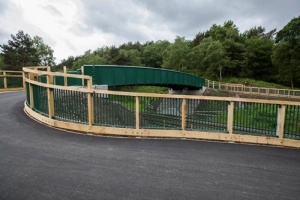Network Rail closes one in ten of Britain’s level crossings

The closure of Moors Gorse level crossing in Cannock Chase, Staffordshire means Network Rail has now closed 700 level crossings across Britain – around 10 per cent of the total – since 2009 as part of its £130m national level crossing investment programme.
Prior to the closure of Moors Gorse, cyclists and walkers had to negotiate two sets of gates to cross the busy Cannock railway line, where trains travel at up to 50mph. It has now been replaced with a bridge which can manage the safe passage of up to 3,000 cyclists – a vital improvement after new mountain bike trails opened recently in the forest, massively increasing the number of people using the crossing.
The majority of crossing closures carried out by Network Rail involve ‘user worked’ crossings, which are mostly on private land with no public right of way. While often situated in rural areas, many cross busy main lines. The barriers or gates need to be operated by the person crossing and warning measures include miniature warning lights, signs or telephones. In many cases an alternative access for the user is either available or has been provided to secure closure. Around 125 footpath crossings have also been closed as part of Network Rail’s improvement programme and footpath crossings are the focus of the company’s current TV advertising campaign: See Track/Think Train.
Martin Gallagher, head of level crossings for Network Rail, said: “The surest way to remove the risk of someone being struck by a train at a level crossing is to close it. Since 2009 we’ve closed 700 and are on course to meet our target of closing 750 by spring next year, but there is much more work to do. Closing a level crossing is not always an easy process and we often need the support of landowners, local authorities and users. I look to their continued support as we aim to improve safety and modernise the rail network for the future.”

